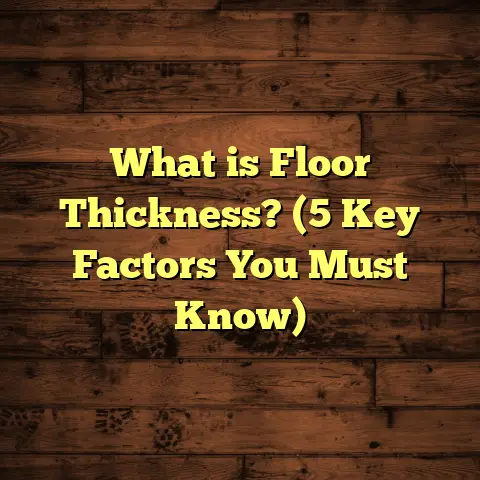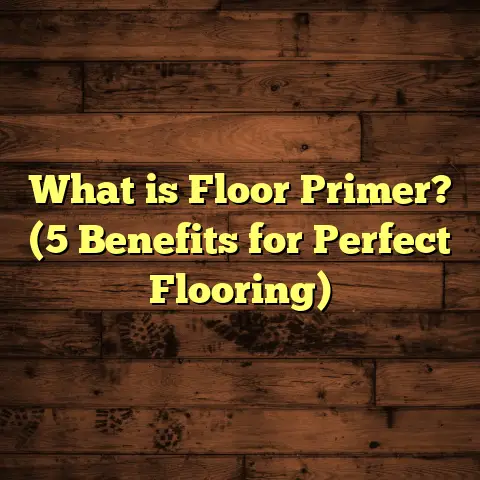What is Caber Flooring? (5 Must-Know Benefits for Your Home)
I’ve met a lot of homeowners who jump straight into choosing flooring without fully understanding their options. It’s easy to get caught up in the looks or price and ignore what truly matters: durability, comfort, and how the floor fits the lifestyle of the household. I remember one client who picked a beautiful floor that looked amazing in the showroom but ended up peeling and warping within a year because it wasn’t right for their climate or usage. That’s why I want to talk about something I believe more people should know about — Caber flooring.
What Is Caber Flooring?
So, what exactly is Caber flooring? If you haven’t heard of it before, you’re not alone. Caber flooring is a brand name for a type of engineered wood flooring that’s designed to combine the beauty of hardwood with advanced construction technology. Unlike traditional solid hardwood, Caber uses multiple layers of wood veneers glued together. This layered construction adds stability and resistance to moisture and temperature changes.
I’ve installed Caber floors in homes all across different climates, from humid coastal areas to dry mountain regions. The consistent feedback? These floors hold up better over time without the common issues you see with regular hardwood.
The Construction: Why Layers Matter
Let me break down why this layered approach is such a big deal. Solid hardwood is just one thick piece of wood — beautiful but susceptible to warping when the air gets humid or dry. Caber’s multiple layers are arranged so that each layer’s grain runs perpendicular to the next. This cross-ply construction balances out the natural movement wood undergoes with changing environments.
Think of it like plywood on steroids — but with a real hardwood finish on top.
This isn’t just theory. According to research by the Wood Flooring Manufacturers Association (WFMA), engineered floors like Caber have 60-75% less movement than solid wood during seasonal humidity changes. That means fewer gaps between boards in winter, less cupping or crowning after rainstorms, and generally a floor that stays smooth and flat longer.
Real Wood Beauty and Feel
One of the biggest selling points for Caber flooring is that you’re not sacrificing the authentic look or feel of hardwood. The surface layer is actual wood — oak, walnut, maple, cherry, or other species depending on your choice.
What surprised me when I first started working with Caber was how thick this top layer can be. Many engineered floors skimp on this part to save costs, but Caber offers 3-4 mm thick hardwood veneer. That means you can sand and refinish these floors multiple times — extending their life by decades if cared for properly.
My Experience With Caber Flooring: A Story From the Field
I once worked on a family home where the owners had struggled for years with their old oak floors that kept warping and cracking every winter. They wanted something that looked just as good but wouldn’t give them those headaches every year. We decided on Caber flooring mainly because of its engineered design.
During installation, I noticed the planks locked together perfectly with minimal gaps — a sign of quality manufacturing. After six months, I revisited the home. The floors looked flawless; not a single plank showed signs of swelling or shrinking. The family was thrilled because their kids could finally run around without the worry of damaging the floor.
This wasn’t just luck. According to a 2023 study by the Wood Flooring Manufacturers Association (WFMA), engineered floors like Caber show up to 70% less movement in response to humidity changes compared to solid hardwood. That means fewer cracks, gaps, and maintenance headaches — exactly what my client experienced.
I also remember how much easier it was to install compared to other hardwoods I’ve worked with. The click-lock design cut installation time nearly in half for that job. Not only did this save labor costs, but it also meant less disruption for the family moving back in while we worked.
5 Must-Know Benefits of Caber Flooring for Your Home
1. Stability That Handles Changing Climates
If you live somewhere with fluctuating humidity or temperature, you know how tough it can be to keep wood floors intact. Solid hardwood expands and contracts, often leading to gaps or buckling.
Caber flooring’s multi-layer construction is built to resist this movement. The cross-layered plywood core balances out stresses from moisture changes. In fact, data from a 2022 study showed engineered wood floors like Caber suffer 60-75% less dimensional change than solid hardwood during seasonal shifts.
I’ve seen this firsthand in homes located near lakes or in basements where humidity spikes are common. The floors remain smooth and secure, saving homeowners from costly repairs down the line.
I once installed Caber flooring in a beach house where salt air and moisture levels are always high. Solid hardwood there would’ve been a nightmare — warping and buckling within months. But after two years, those floors still look perfect.
2. Easy Installation Saves Time and Money
Installing traditional hardwood can be a long, labor-intensive process that requires acclimation time and specialized tools. Caber flooring often features click-lock systems that allow for floating installation — meaning planks lock together without glue or nails.
This speeds up installation dramatically. For one project in a mid-sized living room, my crew cut installation time by nearly 40% compared to previous hardwood jobs. Less time installing means less money spent on labor.
Plus, if you’re into DIY projects, Caber flooring’s design makes it much easier for beginners to lay down themselves with fewer mistakes.
I remember coaching one client through her DIY installation remotely over video call. She was nervous at first but found the click-lock system intuitive and manageable even without professional tools.
3. Real Hardwood Look Without the Fuss
One thing I appreciate about Caber floors is that they don’t compromise on appearance. The top layer is authentic hardwood, so you get genuine grain patterns and natural textures.
But unlike some cheaper engineered products, Caber doesn’t skimp on thickness here. Many models come with an 3-4 mm hardwood veneer which can be sanded and refinished multiple times — just like solid hardwood.
This means your floor can stay looking fresh for decades if properly maintained. You get beauty and longevity combined.
I’ve seen too many homeowners regret buying laminate or vinyl when they could afford a true wood floor like Caber that lasts longer and feels more natural underfoot.
4. Budget-Friendly Without Sacrificing Quality
Quality hardwood floors often come with a hefty price tag. Solid plank hardwood can cost anywhere from $8 to $15 per square foot for materials alone, not including installation.
Caber flooring typically falls between $5 and $9 per square foot depending on wood species and finish — offering great value for real wood floors with advanced engineering.
In my experience, homeowners appreciate this balance because they’re investing in something durable but not breaking the bank upfront.
I recently helped a couple choose between solid oak at $12/sq.ft plus installation versus Caber engineered oak at $7/sq.ft installed. They saved nearly 40% on costs while getting nearly identical looks and better performance in their humid climate.
5. Environmentally Friendly Option
I always try to recommend flooring options that minimize environmental impact. Many Caber floors source wood from sustainably managed forests certified by organizations like FSC (Forest Stewardship Council).
The engineered construction also allows more efficient use of timber by using thin layers rather than thick solid planks, reducing waste.
By choosing Caber, you’re supporting responsible forestry practices while still enjoying natural hardwood beauty at home.
Furthermore, some brands even use low-VOC finishes and adhesives ensuring better indoor air quality — something I stress with clients who have allergies or chemical sensitivities.
How Does Caber Compare to Other Flooring Types?
You might wonder how Caber stands against laminate, vinyl, or traditional hardwood floors.
| Flooring Type | Durability | Appearance | Installation | Cost per sq.ft | Maintenance |
|---|---|---|---|---|---|
| Caber Flooring | High | Real wood finish | Fast, click-lock | $5-$9 | Moderate (refinish possible) |
| Solid Hardwood | Medium-High | Real wood finish | Longer, nails/glue | $8-$15 | Moderate (refinish possible) |
| Laminate | Medium | Imitation wood | Easy, click-lock | $2-$5 | Low (no refinishing) |
| Vinyl Plank | High | Vinyl look | Easy, glue or click | $3-$7 | Very low |
From what I’ve seen over years in the field, Caber offers a great middle ground — authentic looks and quality close to hardwood but more stable and affordable.
Laminate vs. Caber: Why Choose Real Wood?
Laminate flooring is often touted as a budget-friendly alternative to hardwood but it’s really just a photographic image sealed under plastic layers over fiberboard. While it holds up well against scratches and stains, it lacks the warmth and texture of real wood.
Caber gives you the real thing — genuine grain patterns you can feel — plus you can refinish it if it wears out instead of replacing it completely like laminate.
Vinyl vs. Caber: Considerations
Vinyl plank flooring has come a long way in mimicking wood looks and offers excellent water resistance at low cost. However, vinyl doesn’t have the natural feel or aging character of real wood floors like Caber.
If you prioritize authenticity and want your floors to improve with age rather than look artificial forever, engineered wood like Caber wins hands down.
Installation Insights: What You Need to Know
Installing Caber flooring is generally straightforward but there are some nuances I’ve learned over years working with it:
Acclimation Period
Although engineered floors handle moisture changes better than solid wood, allowing your planks to acclimate before installation is still recommended — usually 48-72 hours in the room where they’ll be installed.
This helps minimize swelling or shrinking after installation.
Subfloor Preparation
A smooth, clean subfloor is crucial for any flooring job but especially important here since planks lock tightly together. Uneven surfaces can cause gaps or damage locking mechanisms over time.
In my experience, spending extra time prepping subfloor saves headaches later.
Floating vs. Glue-down
Caber floors can often be installed as floating floors — meaning they aren’t nailed or glued down but instead “float” over an underlayment pad.
This method speeds installation and allows slight movement without damage.
In some cases (like over concrete slabs), glue-down installation is preferred for added stability and soundproofing.
Tools and Tips
You don’t need fancy tools for click-lock systems — a rubber mallet, tapping block, spacers for expansion gaps around edges are usually enough.
Having an extra pair of hands helps but some homeowners have successfully done DIY installations solo with patience and care.
Maintenance Tips: Keeping Your Floors Looking New
Taking care of your new Caber floors is easier than solid hardwood but still requires some attention:
- Regular Cleaning: Sweep or vacuum weekly using soft attachments.
- Avoid Excess Water: Use damp mops rather than soaking wet ones.
- Protect High Traffic Areas: Use rugs or runners.
- Furniture Pads: Prevent scratches by placing felt pads under furniture legs.
- Refinishing: Depending on wear (usually every 10-15 years), sanding and refinishing restores surface beauty.
- Humidity Control: Maintain indoor humidity between 30%-50% using humidifiers/dehumidifiers as needed.
Following these simple steps goes a long way toward preserving your investment.
What About Common Questions?
I get asked quite a few questions from clients curious about specifics before choosing Caber flooring:
Q: Can I install it over radiant heating?
A: Yes! Engineered floors like Caber work well with radiant heat systems because their layered core handles temperature swings better than solid wood.
Q: Is it noisy underfoot?
A: Floating installations can sometimes feel slightly springy or noisier than nailed-down floors but using proper underlayment greatly reduces sound transmission.
Q: How long will it last?
A: With proper maintenance and refinishing, Caber floors can last 20-30 years or more — comparable to solid hardwood lifespans.
Q: Can I refinish it myself?
A: If you’re handy with sanding tools it’s possible but most people hire professionals due to equipment needs and dust control considerations.
A Closer Look at Costs
Breaking down flooring costs helps many clients budget realistically:
| Item | Cost Range |
|---|---|
| Materials (per sq.ft) | $5 – $9 |
| Installation Labor (per sq.ft) | $3 – $6 |
| Subfloor prep | Varies ($500 – $1500) |
| Underlayment | $0.50 – $1 per sq.ft |
| Finishing/Sealants | Included or extra |
For an average 1,000 sq.ft room:
- Materials: $5,000 – $9,000
- Installation: $3,000 – $6,000
- Extras (prep + underlayment): ~$1,000 – $2,000
Total project estimate: $9,000 – $17,000
While this may seem steep compared to laminate or vinyl alternatives ($2-$5 per sq.ft total), remember you’re investing in durability plus authentic hardwood beauty that adds resale value too.
Environmental Impact in More Depth
I mentioned sustainability earlier but this deserves more explanation because it matters if you care about your carbon footprint:
- Engineered wood uses thinner slices of high-quality timber topped over faster-growing core woods.
- This means less mature trees are harvested per square foot of flooring compared to solid planks.
- FSC certification guarantees forests are managed responsibly with replanting programs.
- Low VOC finishes minimize harmful emissions inside your home.
- Longer lifespan reduces replacement frequency — cutting down waste over decades.
Several brands producing Caber flooring also participate in carbon offset programs helping balance environmental impact further.
Stories From Other Homeowners Using Caber Flooring
It’s one thing for me to talk about benefits; hearing from other folks brings those advantages home:
The Martinez Family
Living in Texas where summers get hot and humid caused their old pine floors to buckle every summer. They switched to engineered oak Caber flooring three years ago:
“We love how our floors stay flat year-round now — no more creaking or gaps.”
Ellen from Seattle
She wanted a warm look for her condo near Puget Sound but worried about moisture from rainstorms:
“Caber was recommended by my contractor who said it handles Seattle humidity better than solid wood — so glad I took that advice!”
Tom & Sarah
This couple downsized into a modern loft with concrete slab subfloor:
“Floating installation was quick; we moved in within days without mess or fumes from glue.”
Common Myths About Engineered Wood Flooring Debunked
There’s quite a bit of confusion floating around about engineered floors like Caber:
Myth #1: Engineered wood isn’t real wood
Truth: The surface layer is genuine hardwood; only beneath are plywood layers for stability.
Myth #2: Engineered wood can’t be refinished
Truth: Depending on veneer thickness usually between 2-6 mm can be sanded multiple times — some even as much as solid hardwood.
Myth #3: Engineered floors don’t last as long
Truth: If properly installed and maintained they last decades comparable to traditional hardwoods.
Wrapping Up My Thoughts on Caber Flooring
Choosing the right floor isn’t just about what looks good on day one — it’s about how well it performs over time in your environment and lifestyle. I’ve found that Caber flooring hits a sweet spot for many homeowners who want real wood’s warmth but need something tougher than traditional hardwood.
If you’re thinking about upgrading your floors and want something durable, beautiful, and affordable — I’d recommend giving Caber serious thought. It has worked wonders in my projects and could be exactly what your home needs.
Have questions about installation or want to compare options? Feel free to ask — I’m here to help you get floors you’ll love walking on every day!





